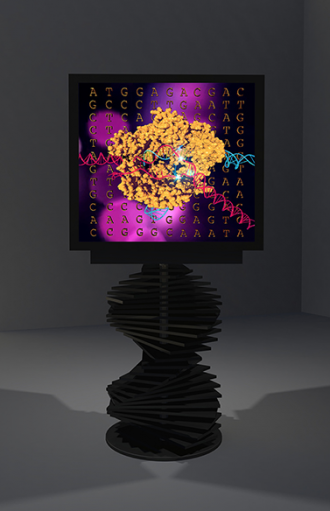Art and science come together seamlessly in the virtual photograph and digital PHSCologram sculpture, CRISPR-Cas9: A Ray of Light, 2017, displayed in the Innovative Genomics Institute lobby. This piece is a collaboration amongst (art)n artists Ellen Sandor, Chris Kemp, Diana Torres, and Azadeh Gholizadeh, with special thanks to Caleb Sandor Taub, and collaborator Jennifer Doudna from The Doudna Lab: RNA Biology and Megan Hochstrasser from the Innovative Genomics Institute (IGI) at the University of California, Berkeley.
The inspiration for A Ray of Light came from Ellen Sandor’s grandson, Caleb, who has an autism disorder. Caleb realized that technology concerning gene editing could impact his life through altering his DNA. Though they are excited by this possibility, his family emphasizes that his brain differences and brain are beautiful as is. CRISPR is an adaptive immune system that can be programed to precisely cut DNA in cells and replace sequences that might otherwise cause disease.
“The promise of CRISPR is that it will be used to help patients that have genetically-caused disease, and I think there’s a lot of excitement about using it to treat disorders that have a very clear single gene that causes the disease. But there’s also, in the future, opportunities to both understand and potentially treat patients that have more complex disorders, such as autism, which have probably multiple genes that are causing that situation.” Jennifer Doudna, PhD, Co-inventor of CRISPR-Cas9 Technology, Chair in Biomedical and Health Sciences at UC Berkeley.
Shannon Jackson, Associate Vice Chancellor for the Arts and Design at the University of California, Berkeley, expresses fondness and excitement for Ellen and (art)n’s collaboration with the Innovative Genomics Institute in illustrating how art and science can complement each other.
“They are constantly showing how new kinds of scientific processes and artistic processes can catalyze each other; that they actually start to create new forms that have not been imagined, new kinds of material, and even a new medium for creative manipulation. And then on the other hand, we also see the important role of the arts as a communicator of scientific discoveries.”
For five months, (art)n team collaborated with the Innovative Genomics Institute at UC Berkeley to create a PHSCologram sculpture depicting the different stages of CRISPR-Cas9 genome editing.
“The whole 3D perspective of it really helps you understand what the molecules look like. Visualization is super important… so as scientists, when we try to figure out what proteins and what different molecules look like, we usually look at them in 3D,” said Megan Hochstrasser, PhD, Science Communications Manager at IGI.
Using Duratrans, Kodalth, and Plexiglass, each panel within the artwork depicts a different stage of CRISPR-Cas9 genome editing to replace a harmful mutation. First, the RNA-guided Cas9 protein searches for its matching DNA target. Next, the guide RNA pairs with one strand of the target DNA, and then Cas9 cuts both strands. Finally, the cell’s repair machinery seals up the break by patching in a stretch of healthy DNA.
View the video made by Ellen Sandor about her art installation below. To learn more about CRISPR at UC Berkeley, click here.
